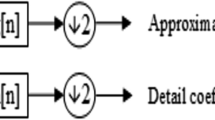Abstract
To predict potential problems and avoid an unexpected breakdown of rotating machinery, a rule-based classifier ensemble approach is presented. Feature reduction was first implemented on a fault decision table using discernibility matrices and the genetic algorithm. The generated rules of the reducts were used to build the candidate base classifiers. Then, several base classifiers were selected according to their diversity and scale. The weights of the selected base classifiers were also calculated based on the support rate measurements. A classifier ensemble was constructed through an integration of the base classifiers using an improved weighted voting technique. Finally, the proposed classifier ensemble was verified based on the vibration data of bearing types SKF6203 and NU205. The accuracy for the SKF6203 bearing type reached 88.75 %, which is at least 5 % higher than that of the three base classifiers for this type of bearing. In addition, the recognition rate for the latter bearing type was 90 %. The reasoning process was much easier to comprehend owing to the semantic descriptions of the rules. The results show that this is a promising and transparent approach for diagnosing typical faults of rotating machinery.
Similar content being viewed by others
References
E. Zio, P. Baraldi and G. Gola, Feature-based classifier ensembles for diagnosing multiple faults in rotating machinery, Applied Soft Computing, 8 (4) (2008) 1365–1380.
T. Figlus and M. Stanczyk, A method for detecting damage to rolling bearings in toothed gears of processing lines, Metalurgija, 55 (1) (2016) 75–78.
L. Meng, J. Xiang, Y. Zhong and W. Song, Fault diagnosis of rolling bearing based on second generation wavelet denoising and morphological filter, Journal of Mechanical Science and Technology, 29 (8) (2015) 3121–3129.
Q. Xiong, Y. Xu, Y. Peng, W. Zhang, Y. Li and L. Tang, Low-speed rolling bearing fault diagnosis based on EMD denoising and parameter estimate with alpha stable distribution, Journal of Mechanical Science and Technology, 31 (4) (2017) 1587–1601.
H. Cao, F. Fan, K. Zhou and Z. He, Wheel-bearing fault diagnosis of trains using empirical wavelet transform, Measurement, 82 (2016) 439–449.
D. Dou, J. Yang, J. Liu and Y. Zhao, A rule-based intelligent method for fault diagnosis of rotating machinery, Knowledge-Based Systems, 36 (2012) 1–8.
Y. Tian, J. Ma, C. Lu and Z. Wang, Rolling bearing fault diagnosis under variable conditions using LMD-SVD and extreme learning machine, Mechanism and Machine Theory, 90 (2015) 175–186.
P. Borghesani, P. Pennacchi, R. B. Randall, N. Sawalhi and R. Ricci, Application of cepstrum pre-whitening for the diagnosis of bearing faults under variable speed conditions, Mechanical Systems and Signal Processing, 36 (2) (2013) 370–384.
N. Sawalhi and R. B. Randall, Vibration response of spalled rolling element bearings: Observations, simulations and signal processing techniques to track the spall size, Mechanical Systems and Signal Processing, 25 (3) (2011) 846–870.
A. Dany et al., Angle time cyclostationarity for the analysis of rolling element bearing vibrations, Measurement, 75 (2015) 29–39.
J. Antoni, Cyclic spectral analysis of rolling-element bearing signals: Facts and fictions, Journal of Sound and Vibration, 304 (2-5) (2007) 497–529.
D. Dou and S. Zhou, Comparison of four direct classification methods for intelligent fault diagnosis of rotating machinery, Applied Soft Computing, 46 (2016) 459–468.
B. Li, P.-Y. Liu, R.-X. Hu, S.-S. Mi and J.-P. Fu, Fuzzy lattice classifier and its application to bearing fault diagnosis, Applied Soft Computing, 12 (6) (2012) 1708–1719.
M. Straczkiewicz, P. Czop and T. Barszcz, Supervised and unsupervised learning process in damage classification of rolling element bearings, Diagnostyka, 17 (2) (2016) 71–80.
M. Tabaszewski, Optimization of a nearest neighbors classifier for diagnosis of condition of rolling bearings, Diagnostyka, 15 (1) (2014) 37–42.
A. Chandra and X. Yao, Evolving hybrid ensembles of learning machines for better generalisation, Neurocomputing, 6 (7) (2006) 686–700.
A. Øhrn, Discernibility and rough sets in medicine: Tools and applications, Ph.D. Thesis, Department of Computer and Information Science, Norwegian University of Science and Technology (1999).
S. Vinterbo and A. Øhrn, Minimal approximate hitting sets and rule templates, International Journal of Approximate Reasoning, 25 (2) (2000) 123–143.
L. Chambers, Practical handbook of genetic algorithms: Applications Vol. I; new frontiers Vol. II, CRC Press (1995).
D. Dou, J. Yang, J. Liu, Z. Zhang and H. Zhang, Softsensor modeling for separation performance of densemedium cyclone by field data, International Journal of Coal Preparation and Utilization, 35 (3) (2015) 155–164.
D. Dou, J. Yang, J. Liu and H. Zhang, A novel distribution rate predicting method of dense medium cyclone in the Taixi coal preparation plant, International Journal of Mineral Processing, 142 (2015) 51–55.
L. I. Kuncheva and C. J. Whitaker, Ten measures of diversity in classifier ensembles: Limits for two classifiers, A DERA/IEE Workshop on Intelligent Sensor Processing, 50 (2001) 10/1-1010.
A. Tsymbal, M. Pechenizkiy and P. Cunningham, Diversity in search strategies for ensemble feature selection, Information Fusion, 6 (1) (2005) 83–98.
Case Western Reserve University, Bearing data center. http://www.eecs.cwru.edu/laboratory/bearing (accessed 26. 11.10).
A. Widodo et al, Fault diagnosis of low speed bearing based on relevance vector machine and support vector machine, Expert Systems with Applications, 36 (2009) 7252–7261.
Author information
Authors and Affiliations
Corresponding authors
Additional information
Dongyang Dou received a Ph.D. degree in School of Mechanical and Power Engineering from Nanjing University of Technology, Nanjing, China, in 2010. His current research interests include control, optimization, and fault diagnosis.
Yuling Wang received a Ph.D. degree in School of Chemical Engineering and Technology from China University of Mining and Technology, Xuzhou, China, in 2009. Her current research interests include expert systems in mineral processing.
Rights and permissions
About this article
Cite this article
Dou, D., Jiang, J., Wang, Y. et al. A rule-based classifier ensemble for fault diagnosis of rotating machinery. J Mech Sci Technol 32, 2509–2515 (2018). https://doi.org/10.1007/s12206-018-0508-y
Received:
Revised:
Accepted:
Published:
Issue Date:
DOI: https://doi.org/10.1007/s12206-018-0508-y




